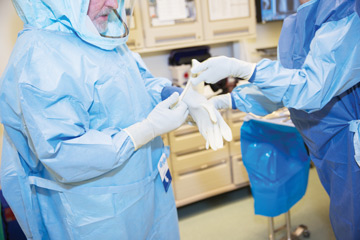Amber H. Mitchell, DrPH, MPH, CPH, president and executive director of the International Safety Center in Houston, Texas, points out that this year is the 20th anniversary of the Needlestick Safety and Prevention Act, which requires facilities to identify, evaluate and implement safer medical devices. This should be a banner year for sharps safety, but there are still big issues going unaddressed in many ORs. Dr. Mitchell says the data her organization has collected reveal the largest numbers of sharps injuries are occurring from suture needles, which account for almost a quarter of all devices used in healthcare settings that cause sharps-related harm.
“Typically, disposable syringes have been the number one device causing injuries year after year, but over the last two to three years we’ve seen suture needles surpass them,” says Dr. Mitchell, who adds nurses typically are injured by disposable syringes, while physicians typically are injured by suture needles.
“There have been a lot of advancements in safer devices for disposable syringes — retracting needles and microneedles — and using oral medications instead of injectables,” she says. “For skin closure, there are all kinds of alternatives — adhesives, zipper closures, staples — but surgeons aren’t evaluating or adopting them. For some reason, the surgical community is slower to adopt innovations for sharps safety than more complicated medical devices such as robotics.”
Why the reluctance? Dr. Mitchell believes some surgeons and surgical teams may be reluctant to adopt sharps safety technologies because they don’t feel comfortable using them. But as with many transitions, this one appears to be generational.
“As we’re starting to see younger surgeons come into clinical and surgical care, they may be more likely to adopt newer technologies specifically for sharps safety because they seem more hyperaware of the risk of infectious diseases,” says Dr. Mitchell.
If suture injuries are usually suffered by surgeons, why don’t more of them seem to care enough to change their practices? “That surprises me,” says Dr. Mitchell. “When I pull up data about sharps injuries in the OR from 2018, sutures were responsible for 45.6% of them,” she says. Furthermore, her data show that 52.8% of all sharps injuries in the OR occur to physicians.
As a result, Dr. Mitchell is concerned about infection risks in the OR. If the surgeon gets stuck with a suture and is bleeding through single or even double-gloves, there is potential cross-transmission of the physician’s and patient’s blood,” she says. “There’s the potential the surgeon could expose the patient to infectious diseases, which is a whole different risk profile for the facility from a liability point of view.”
Dr. Mitchell says sharps injuries to sterile processing personnel usually occur as they are transporting soiled instruments to their area, as well as during the initial washing of the items during the decontamination phase.
Interestingly, she says, “We know from our sharps injury data that almost 25% of all sharps injuries occur to the non-user. That means they’re occurring downstream to environmental service workers, to SPD staffers, to waste haulers.”
Rates of adopting sharps safety technology would improve if surgeons trained with the devices during their schooling, according to Dr. Mitchell.
“That’s another frustration because these newer technologies for sharps safety are typically having no visibility in medical school,” she says. “Unless their attendings or surgical mentors are using them where they’re being trained, young surgeons don’t have access to them.”
Blunted sutures have been around for decades, and even the uptake from sharp to blunt has not been very good, says Dr. Mitchell. That’s somewhat surprising, because there are other benefits to switching out sharp sutures for safer options. Dr. Mitchell says zipper closure manufacturers tout better cosmetic end results, and the products could improve SSI prevention because the zipper allows for fuller closure of the incision — “almost like an adhesive bandage and a zipper all in one,” she says.
.svg?sfvrsn=be606e78_3)



.svg?sfvrsn=56b2f850_5)